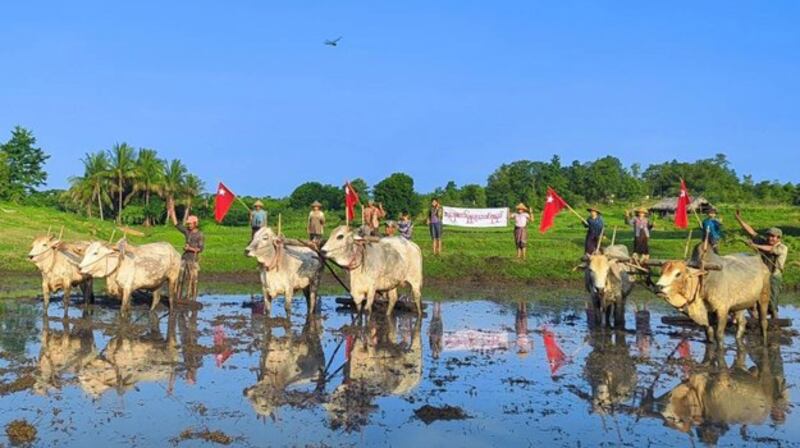Anti-junta protesters have returned to the streets of Myanmar’s Sagaing region, despite intense crackdowns and raids by military forces, organizers of the demonstrations said.
Residents in the northwestern region are not only leading armed resistance efforts, but also holding nonviolent protests again as they did in the months following the February 2021 military coup that seized power from the country’s elected government, local activists said.
The takeover triggered a wave of resistance across the country, prompting the military to respond with violence and mass arrests. Despite the crackdowns, citizens took up arms in self-defense, forming groups known as People’s Defense Forces, while the coup also stoked conflicts that had been on the decline in ethnic borderland areas.
Sagaing emerged early on as a hotbed of armed dissent and remains so more than two and a half years after the coup with armed conflicts occurring nearly every day between resistance forces and junta troops.
Hundreds of residents of Kani, Mingin, Salingyi, Yinmarbin, Kalay, Khin-U, Ye-U and Chaung-U townships are participating in peaceful public protests that resumed in early October, activists leading the protests said.
They are demanding that people cut off the flow of money to the junta’s coffers, boycotting military-owned products and rejecting military-sponsored elections, the sources said.
Protest groups
To resurrect the popular movement, protest groups in different townships formed a regional committee on Oct. 1 to better coordinate public marches, Khant Wai Phyo, a member of the Monywa People’s Strike Committee, told Radio Free Asia.
“The number of people who can be armed is limited, [but] on the other hand, there is a large majority of people who do not accept the military dictatorship at all,” he said. “Therefore, the public has joined in activities that the majority of the public can do — demonstrating that they do not accept the military.”
Nearly 40 protest groups are now active at the township and village levels, he said.

As they did in the period following the coup when people took to the streets to voice their displeasure with the regime, residents are taking huge risks by participating in the anti-regime protests because junta soldiers violently crack down on them, said an official from the Kani Strike Committee.
“Because of such continuous movements, we support [the anti-regime protesters] and strengthen the movement,” he said.
“The movement in Sagaing is strong, [and] people take risks to join the activities,” he said.
The people of Sagaing region are not acting out of desperation amid ongoing crackdowns by the junta, but rather are fighting back with a strong will, said Nay Zin Latt, a lawmaker for Sagaing region’s Kanbalu township under the former democratically elected government toppled by the military.
“The junta is attempting to instill fear in the population, though the public is actively participating in public activities in various forms without backing down,” he said. “Even after more than two or three years of the revolution, it still hasn’t weakened.”
Boycotts
Protesters are urging others in the region not to buy or sell military-owned products, Nay Zin Latt said, to prevent the cash-strapped ruling junta, subjected to international sanctions, from benefiting financially.
An official from Kanbalu township People’s Defense Force said locals can easily conduct protests there because the resistance fighters control about 70% of the township.
Junta soldiers “can only stay on their bases with arms,” he said. “As soon as they leave their posts, they will be in enemy territory.”
Sagaing region is leading the country’s ongoing resistance movement with a combination of “brains and brawn” to oppose the military dictatorship, said Tay Zar San, an anti-regime protest leader.
“During the people’s Spring Revolution, they resisted with brawn by conducting an armed struggle, but on the other hand, they are also [using] their brains to stage popular movements,” he said, referring to the nationwide revolutionary struggle to permanently remove the military from Myanmar’s politics.
The intention of the popular movement is to underline to the international community that despite long military rule, the people continue to oppose the junta.
Though popular protests are going strong again, more than 813,000 civilians in Sagaing region have been displaced by armed conflict, according to the latest figure from the U.N. Office for the Coordination of Humanitarian Affairs, or OCHA.
Translated by Htin Aung Kyaw for RFA Burmese. Edited by Roseanne Gerin and Malcolm Foster.

